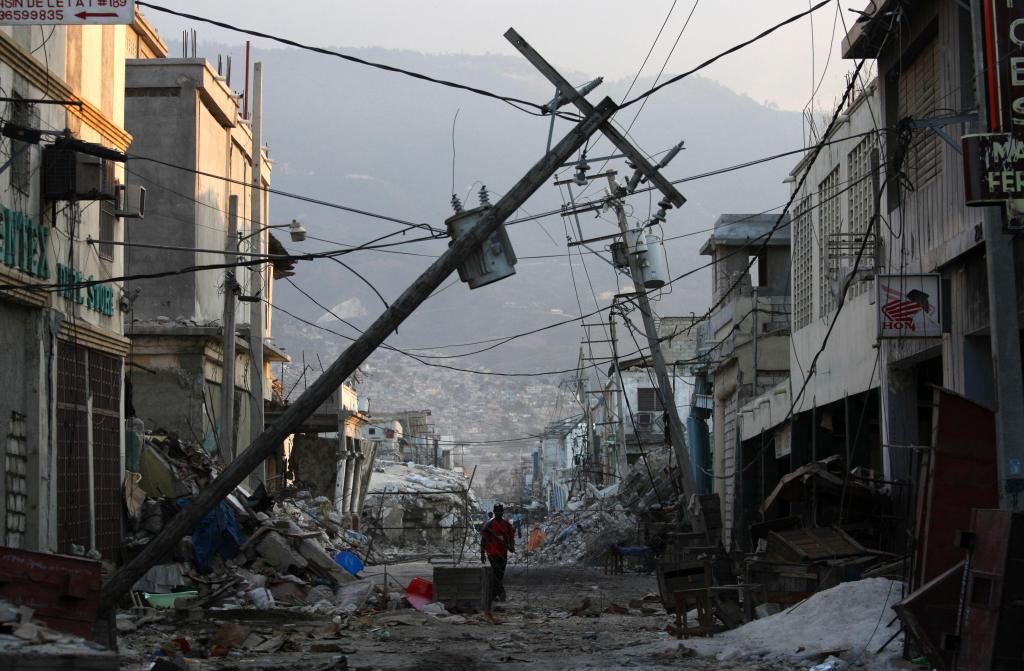PORT-AU-PRINCE, Haiti — Six weeks after a catastrophic earthquake flattened downtown Port-au-Prince, power has returned to nearly half the city’s neighborhoods.
Most, however, are in the hilly southern suburbs, which look down at night on the miles of near blackness where most of the quake-rendered homeless abide in teeming tent cities.
Even before the Jan. 12 quake, electrical service in Haiti meant an average of 10 hours of power a day delivered by a rickety grid to just a quarter of the population — not even half of them paying customers.
If Haiti now hopes to shake off its status as the Western Hemisphere’s poorest nation, experts say, it will need to build a power system far better than the highly subsidized, cash-hemorrhaging utility it had before the disaster.
It is starting almost from scratch.
The state-owned Electricite d’Haiti, like the government, is essentially broke. Fewer customers than ever are able or willing to pay. Their jobs disappeared along with their homes in 30 violent seconds.
The country immediately needs $40 million to get its grid back to pre-quake status and pay its 2,500 workers, hundreds of whom are living in tents, the utility’s director-general, Serge Raphael, said in an interview.
Then it needs to figure out how to finance itself — the payroll alone is $15 million a month — as well as provide power to the millions of Haitians who can’t afford it.
”This is one of the most pressing problems that Haiti is facing,” said Ernest Paultre, the U.S. Agency for International Development’s chief engineer for Haiti.
The challenge is as glaring as the bare yellow bulb of a makeshift street lamp, hooded by a scrap of tin, that lights up a dirt path in the Debrose 33 neighborhood on the side of a ravine.
Joseph Dessier, 47, now lives with his wife and five children in a shack cobbled together of tin, paperboard and a tarp in the yard of a former auto repair shop alongside neighbors who also lost their homes.
The camp’s residents power lamps, TVs, cell phone chargers and blow driers off a single line that somebody strung up from the ravine.
Nobody is paying for the electricity.
Then again, hardly anyone in Debrose 33 was paying before the quake.
”You could count on your fingers the number of people who had meters and were able to pay for electricity,” said Dessier.
So many people filched power that the grid would periodically overload the neighborhood transformer, causing it to blow. Two days later, a utility company crew would show up to fix it.
”All the way down the ravine people were tapping into the line,” he said. ”It’s not something you can stop.”
Dessier, a university messenger, said he paid his bill in full until rates doubled last year due to rising oil prices. Afterward, ”I managed to pay some of it but not all,” he said.
Utility chief Raphael said his biggest problem has always been the utility’s inability to collect from its users.
”In the slums, how can you make people pay for power?” he said. The utility has only been able to collect on between 10 to 15 percent of December’s bills, he said, and it only expects about one in three ratepayers to pay up through the end of April.
When the quake struck, the company was installing a computerized system to improve bill collection and management that was bankrolled by a $14 million grant from the Inter-American Development Bank.
Another $18 million grant is in the pipeline for this year, but rehabilitation money isn’t anywhere near enough to begin shoring up the utility, says Lumas Kendrick Jr., IADB energy specialist in Haiti.
”The global community has to step up,” added Kendrick, noting that the utility has been running a deficit of about $80 million a year out of a $200 million budget.
”The real issue is how we get more funding,” he said Wednesday. ”The fact of the matter is: The government doesn’t have the resources to pay any civil servants.”
Rebuilding Haiti’s power grid and expanding its generation capacity are among priorities — along with roads, water and sanitation — for an international donors conference set for late March at U.N. headquarters in New York.
Until then, without additional emergency funds, little can be done to further restore service on a hobbled distribution network. Power poles and cables still lie snapped on streets all over town.
”It’s going to take six months to a year to get the materials in here to build up the areas that don’t have power now,” said Myk Manon, an engineer with the U.S. National Rural Electric Cooperative Association who has been managing international efforts to restore electrical power.
Copy the Story Link
Send questions/comments to the editors.



Success. Please wait for the page to reload. If the page does not reload within 5 seconds, please refresh the page.
Enter your email and password to access comments.
Hi, to comment on stories you must . This profile is in addition to your subscription and website login.
Already have a commenting profile? .
Invalid username/password.
Please check your email to confirm and complete your registration.
Only subscribers are eligible to post comments. Please subscribe or login first for digital access. Here’s why.
Use the form below to reset your password. When you've submitted your account email, we will send an email with a reset code.